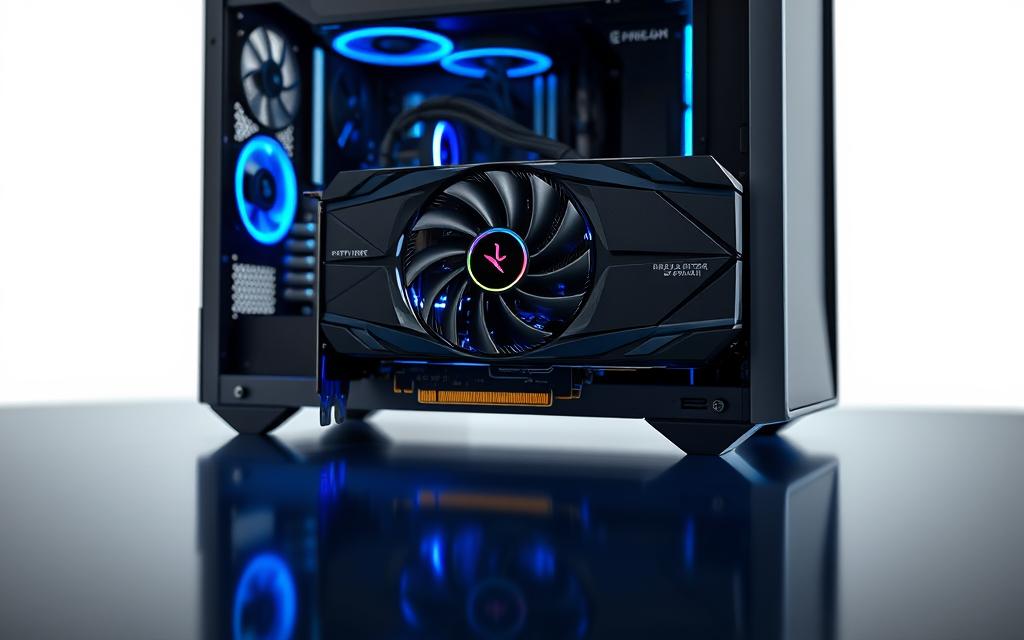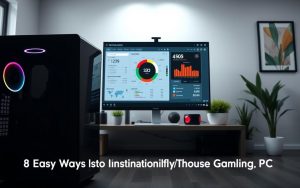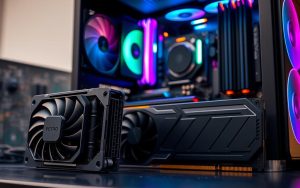Table of Contents
As gaming technology advances, choosing the right GPU becomes crucial for an optimal experience. By 2025, the demands of modern games will push hardware to new limits. High resolutions, fast refresh rates, and advanced features like ray tracing will shape the requirements for your setup.
Leading brands like Nvidia GeForce RTX, AMD Radeon, and Intel Arc are already setting the stage for future innovations. The upcoming Nvidia RTX 50-series, AMD RX 9000-series, and Intel Arc Battlemage promise groundbreaking performance. Balancing price and performance will be key, especially with evolving market conditions.
Emerging technologies such as DLSS 4 and XeSS 2 will further enhance gaming visuals and efficiency. Understanding VRAM capacity and power efficiency will help you make informed decisions. For more insights, check out this guide on the best GPUs available today.
Introduction to Graphics Cards for Gaming in 2025
The gaming landscape in 2025 demands cutting-edge hardware for seamless experiences. With titles like Alan Wake 2 requiring 12GB+ VRAM, choosing the right GPU is essential. Modern games push boundaries with high resolutions, ray tracing, and advanced upscaling technologies.
The Importance of a Good GPU for Gaming
A high-quality GPU ensures smooth gameplay and stunning visuals. The latest GPUs, such as the Nvidia RTX 5090 and Intel Arc B580, deliver significant performance gains over their predecessors. These cards achieve 168.3 FPS at 1080p and 98.2 FPS at 4K, making them ideal for demanding games.
Ray tracing and DLSS 4 enhance realism and efficiency, while monitor synchronization technologies like G-Sync and FreeSync eliminate screen tearing. However, thermal design and power consumption remain critical considerations, especially with GPUs exceeding 450W TDP.
What to Consider When Choosing a Graphics Card
When selecting a GPU, prioritize performance, VRAM capacity, and compatibility. High-end GPUs offer 30-40% better performance than mainstream options, but they come at a higher cost. Ensure your power supply can handle the card’s requirements, and check for PCIe 5.0 compatibility for future-proofing.
Here’s a comparison of high-end and mainstream GPUs:
| Feature | High-End GPUs | Mainstream GPUs |
|---|---|---|
| Performance | 30-40% higher | Balanced |
| VRAM | 16GB+ | 8-12GB |
| Power Draw | 394W (RTX 5090) | 123W (RTX 4060) |
| Price | Premium | Affordable |
Balancing these factors will help you find the perfect GPU for your gaming setup. Whether you prioritize ray tracing or resolution, understanding your needs is key to making the right choice.
Understanding GPU Performance in 2025
In 2025, GPU performance will redefine gaming experiences. With cutting-edge technologies like ray tracing and DLSS 4, modern games demand hardware that delivers smooth frame rates and stunning visuals. The latest GeForce RTX and AMD RDNA4 GPUs are setting new benchmarks for performance.
Key Performance Metrics for Gaming GPUs
When evaluating a GPU, frame rates per second (FPS) are a critical metric. The Nvidia RTX 5090, for example, shows a 73% improvement over the RTX 4090 in AI benchmarks. This leap in performance ensures smoother gameplay even in demanding titles.
VRAM bandwidth is another key factor. With GDDR7 memory, the RTX 50-series achieves 28 Gbps, enabling faster data transfer. This is crucial for high-resolution games and advanced features like ray tracing.
How GPU Performance Has Evolved Over Time
Over the years, GPU performance has seen significant advancements. The AMD RX 9070 XT offers 30% gains over its predecessor, the RX 7800 XT. Similarly, Intel Arc B580 matches the RTX 4060 in 1080p gaming, showcasing the rapid progress in this generation.
Thermal velocity boost and DX12 Ultimate support further enhance efficiency and realism. These innovations ensure that GPUs not only perform better but also remain future-proof for upcoming games.
“The next generation of GPUs is not just about raw power but also about delivering a seamless gaming experience.”
Real-world gaming performance often differs from synthetic benchmarks. Multi-frame generation technologies like DLSS 4 and XeSS 2 play a crucial role in enhancing perceived smoothness, making modern GPUs more efficient than ever.
What Graphics Card Do I Need for a Gaming PC?
Selecting the ideal GPU for your gaming setup in 2025 requires careful consideration of your specific needs. The right choice ensures smooth gameplay, stunning visuals, and future-proofing for upcoming titles. Whether you’re gaming at 1080p, 1440p, or 4K, understanding your requirements is essential.
Factors to Consider Based on Your Gaming Needs
Your gaming needs determine the type of GPU you should invest in. For 1080p gaming, options like the RX 7600 or RTX 4060 deliver excellent performance at affordable prices. These cards are perfect for casual gamers or those on a budget.
For 1440p gaming, consider the RX 7700 XT or RTX 4070 Super. These GPUs handle higher resolution and demanding settings with ease. If you’re aiming for 4K gaming, the RX 7900 XTX or RTX 4090 are top-tier choices, offering unmatched performance for the most demanding titles.
- VRAM: 8GB for 1080p, 12GB for 1440p, 16GB+ for 4K.
- Display Outputs: HDMI 2.1 and DisplayPort 2.1 ensure compatibility with modern monitors.
- Case Compatibility: Triple-slot coolers require spacious cases.
Matching GPU Performance to Your Monitor’s Resolution
Your monitor’s resolution plays a crucial role in GPU selection. For 1080p gaming, the RX 7600 or RTX 4060 are cost-effective options. These cards deliver smooth frame rates without breaking the bank.
For 1440p gaming, the RX 7700 XT or RTX 4070 Super strike a balance between price and performance. They handle high settings and ray tracing with ease. If you’re gaming at 4K, the RX 7900 XTX or RTX 4090 are the best choices, offering unparalleled visuals and performance.
Ultrawide monitors (3440×1440) demand more from your GPU. Ensure your choice has sufficient VRAM and power to handle the increased pixel count. For multi-monitor setups, consider GPUs with higher power efficiency and multiple display outputs.
For more insights on building the perfect gaming setup, check out this guide on the best gaming computers.
Top Graphics Cards for 1080p Gaming in 2025
In 2025, 1080p gaming remains a popular choice for many gamers, offering a balance of performance and affordability. Whether you’re into esports or AAA titles, selecting the right GPU ensures smooth gameplay without overspending. Let’s explore the best options for both budget-conscious and performance-driven gamers.
Best Budget Options for 1080p Gaming
For gamers on a budget, the RX 7600 stands out with its $260 price tag and 52.9 FPS baseline. It’s a solid choice for casual gaming and esports titles. Another contender is the Intel Arc A580, which offers competitive value at a lower cost.
When comparing sub-$300 options, the RX 6600 and Arc A580 are excellent picks. Both deliver smooth 1080p performance in ultra settings, making them ideal for gamers who prioritize value over premium features.
- Energy Efficiency: Both GPUs are designed to minimize power consumption, reducing long-term costs.
- Cooling Solutions: Compact designs make them suitable for small form factor (SFF) builds.
- Driver Maturity: AMD’s drivers are well-established, while Intel continues to improve its software support.
High-Performance GPUs for 1080p Gaming
For those seeking top-tier performance, the GeForce RTX 4060 and Intel Arc B580 are standout choices. The RTX 4060, priced at $320, achieves 66.2 FPS, while the Arc B580 delivers 65.8 FPS at 1080p. Both GPUs excel in demanding AAA titles and esports games.
Frame generation technologies like DLSS 3 and FSR 3 further enhance performance, ensuring smoother gameplay. The RTX 4060’s DLSS 3 support gives it an edge in supported titles, while the Arc B580’s XeSS compatibility offers a versatile alternative.
“The next generation of GPUs is not just about raw power but also about delivering a seamless gaming experience.”
For gamers planning future upgrades, these GPUs provide a solid foundation. Their power efficiency and advanced features ensure they remain relevant for years to come.
Best GPUs for 1440p Gaming in 2025
1440p gaming continues to dominate the market in 2025, offering a sweet spot between performance and visual fidelity. With games becoming more demanding, choosing the right GPU ensures smooth gameplay and stunning visuals. Whether you’re a casual gamer or a competitive player, there’s a GPU tailored to your needs.
Mid-Range GPUs for 1440p Gaming
For gamers looking to balance performance and money, mid-range GPUs like the RTX 4070 and RX 7800 XT are excellent choices. The RTX 4070, priced at $580, delivers 94.3 FPS at 1440p, making it a top performer in its class. Its 12GB VRAM ensures smooth gameplay in most modern titles.
The RX 7800 XT, priced slightly higher at $690, achieves 90.9 FPS. With 16GB VRAM, it’s better suited for future-proofing and handling higher textures. Both GPUs offer excellent price/performance ratios, making them ideal for gamers who want quality without overspending.
High-End GPUs for 1440p Gaming
For those seeking uncompromising performance, the RX 7900 XT is a standout choice. Priced at $799, it handles 1440p ultrawide gaming with ease, delivering exceptional frame rates and visuals. Its 20GB VRAM ensures it can handle the most demanding games and multitasking scenarios.
High-end GPUs like the RX 7900 XT also excel in content creation, making them versatile for gamers who stream or edit videos. Their advanced cooling solutions, often featuring triple-fan designs, ensure optimal thermal performance even under heavy loads.
| Feature | RTX 4070 | RX 7800 XT | RX 7900 XT |
|---|---|---|---|
| Price | $580 | $690 | $799 |
| VRAM | 12GB | 16GB | 20GB |
| FPS at 1440p | 94.3 | 90.9 | 95+ |
| Ray Tracing | Excellent | Good | Excellent |
“Investing in a high-end GPU ensures you’re ready for the next generation of games, offering both performance and longevity.”
When choosing a GPU for 1440p gaming, consider factors like VRAM, thermal performance, and PCIe compatibility. The RTX 4070 and RX 7900 XT are both excellent options, catering to different budgets and needs. With the market evolving rapidly, these GPUs provide a solid foundation for years of gaming enjoyment.
Top Graphics Cards for 4K Gaming in 2025
4K gaming in 2025 is set to redefine visual fidelity and performance expectations. With advancements in GPU technology, achieving smooth gameplay at ultra-high resolutions is now more accessible than ever. Whether you’re a casual gamer or a hardcore enthusiast, there’s a GPU tailored to your needs.
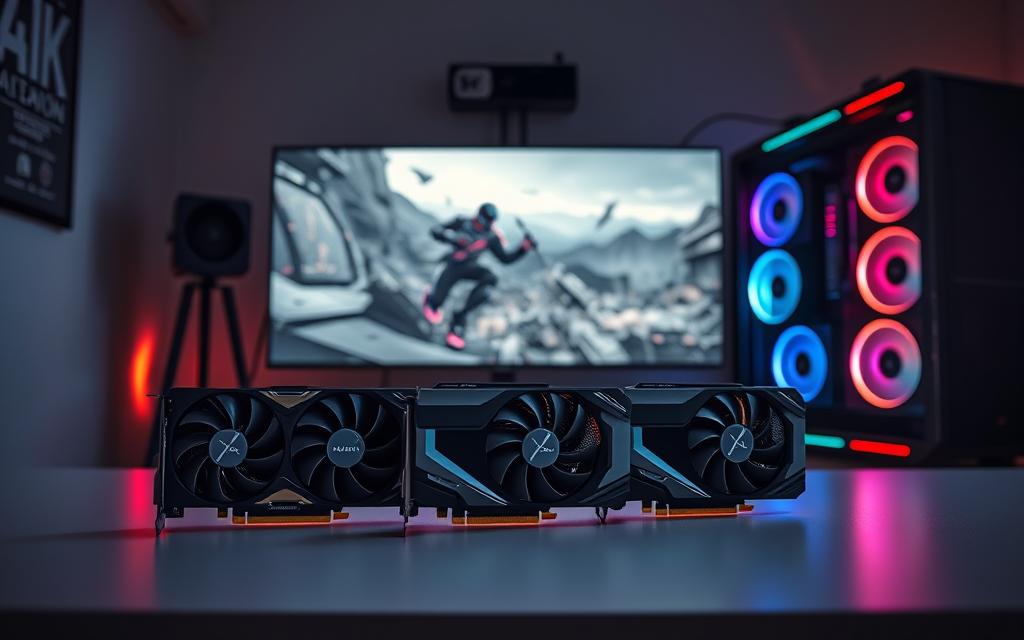
Best GPUs for 4K Gaming on a Budget
For gamers seeking 4K performance without breaking the bank, the RX 7900 XTX is a standout choice. Priced at $1,238, it delivers 54.6 FPS in native 4K, making it a solid option for budget-conscious players. Its GDDR6X memory ensures fast data transfer, while its efficient cooling system keeps temperatures in check.
When comparing native 4K vs upscaled performance, technologies like DLSS 4 enable 4K/120Hz gaming with multi-frame generation. This makes the RX 7900 XTX a versatile choice for both gaming and content creation.
- Power Supply: Ensure your PSU can handle 450W+ requirements.
- Cooling Solutions: Triple-fan designs offer optimal thermal performance.
- Future-Proofing: PCIe 5.0 compatibility ensures longevity.
High-End GPUs for 4K Gaming
For those who demand the best, the RTX 4090 is the ultimate choice. Priced at $3,789, it achieves 98.2 FPS at 4K, setting a new benchmark for performance. Its GDDR7 memory and advanced ray tracing capabilities make it ideal for the most demanding games.
Liquid cooling solutions are highly recommended for flagship GPUs like the RTX 4090. These systems not only enhance performance but also reduce noise levels, providing a more immersive gaming experience.
“Investing in a high-end GPU ensures you’re ready for the next generation of games, offering both performance and longevity.”
Multi-GPU rendering solutions are also worth considering for extreme setups. However, single-GPU configurations like the RTX 4090 often provide better value and compatibility.
Ray Tracing and DLSS: What You Need to Know
Ray tracing and DLSS are transforming the way we experience modern games. These technologies enhance visual realism and performance, making them essential for next-level gaming. As games become more demanding, understanding how these features work can help you make informed decisions about your hardware.
How Ray Tracing Enhances Gaming Graphics
Ray tracing simulates the way light interacts with objects, creating lifelike reflections, shadows, and lighting effects. The RTX 5090, for example, shows a 138% improvement in ray tracing performance over the RTX 4090. This leap in technology ensures that games look more realistic than ever.
Hybrid rendering pipelines combine traditional rasterization with ray tracing, optimizing performance without sacrificing visual quality. Path tracing, a more advanced form of ray tracing, is also gaining traction, offering even greater realism. However, these techniques require significant VRAM, with 16GB+ becoming the standard for high-end GPUs.
The Role of DLSS in Modern Gaming
DLSS (Deep Learning Super Sampling) uses AI to upscale lower-resolution images, boosting frame rates without compromising visual quality. DLSS 4 introduces multi-frame generation, reducing latency by 10% and improving smoothness in fast-paced games. This technology is particularly beneficial for 4K gaming, where maintaining high frame rates can be challenging.
FSR 4, AMD’s alternative to DLSS, is limited to RX 9000-series GPUs. While both technologies aim to enhance performance, DLSS 4 currently offers superior AI upscaling quality and fewer artifacts. Driver-level optimizations further refine these features, ensuring compatibility with a wide range of games.
“Ray tracing and DLSS are not just about improving visuals; they’re about delivering a seamless and immersive gaming experience.”
As adoption rates for ray tracing and DLSS continue to rise, these technologies are expected to become standard in future games. By 2026, nearly all AAA titles are likely to support these features, making them a crucial consideration for gamers looking to future-proof their setups.
AMD vs. Nvidia: Which Brand is Best for Gaming in 2025?
The battle between AMD and Nvidia continues to shape the gaming landscape in 2025. Both brands have made significant strides in GPU technology, offering gamers a wide range of options. Whether you prioritize performance, price, or advanced features, understanding the strengths of each brand is crucial.
Comparing AMD and Nvidia GPUs
When comparing AMD and Nvidia, architecture efficiency plays a key role. Nvidia’s Ada Lovelace architecture, found in the GeForce RTX 50-series, excels in ray tracing and AI acceleration. Meanwhile, AMD’s RDNA4 architecture, powering the Radeon RX 9000-series, focuses on raw compute power and energy efficiency.
Driver updates are another critical factor. Nvidia is known for frequent and stable driver releases, ensuring compatibility with the latest games. AMD has improved its driver support, but Nvidia still holds an edge in this area. Proprietary technologies like DLSS 4 and FSR 4 also set the brands apart, with DLSS offering superior AI upscaling quality.
Which Brand Offers Better Value?
When it comes to value, AMD often provides more VRAM at a lower price. For example, the RX 9070 offers 16GB VRAM at $669, while the RTX 5070, priced at $600, comes with 12GB. However, Nvidia leads in ray tracing performance, with a 40-50% advantage in supported titles.
Content creators may prefer Nvidia due to its optimization in software like Adobe Premiere Pro. On the other hand, AMD’s open-source approach to technologies like FSR makes it a favorite among budget-conscious gamers. Warranty and support policies are also worth considering, with both brands offering competitive packages.
“The choice between AMD and Nvidia ultimately depends on your specific needs and budget. Both brands deliver exceptional value in their respective niches.”
As the market evolves, AMD and Nvidia are expected to maintain their dominance. By 2025, both brands will likely introduce even more advanced GPUs, further intensifying the competition. Whether you choose AMD or Nvidia, investing in the right GPU ensures a future-proof gaming experience.
Intel Arc GPUs: A Viable Option for Gamers?
Intel’s foray into the GPU market has sparked significant interest among gamers. With the launch of the Intel Arc series, the tech giant aims to challenge established players like Nvidia and AMD. Offering a mix of performance and value, these GPUs are designed to cater to both casual and hardcore gamers.
Intel’s Entry into the GPU Market
Intel’s entry into the GPU market marks a significant shift in the industry. The Intel Arc series, powered by the Battlemage architecture, promises a 100% improvement in ray tracing performance. This leap in technology positions Intel as a serious contender in the high-performance GPU space.
Driver stability has been a key focus for Intel, with frequent updates improving compatibility and performance. While initial releases faced challenges, recent improvements have made Intel Arc GPUs more reliable for gaming and content creation.
Performance and Pricing of Intel Arc GPUs
The Arc A750 and Arc B580 are standout models in Intel’s lineup. Priced at $341, the Arc B580 competes directly with the RTX 4060, offering similar performance at a lower cost. For gamers on a budget, these GPUs provide excellent value without compromising on quality.
XeSS 2, Intel’s upscaling technology, requires Intel Arc GPUs for full functionality. This feature enhances gaming visuals and performance, making it a key selling point for the series. Additionally, AV1 encoding support gives Intel an edge in content creation, particularly for streamers and video editors.
| Feature | Intel Arc B580 | RTX 4060 |
|---|---|---|
| Price | $341 | $320 |
| Performance | 65.8 FPS | 66.2 FPS |
| VRAM | 12GB | 8GB |
| Ray Tracing | Good | Excellent |
Motherboard compatibility remains a consideration for Intel GPUs. While most modern motherboards support PCIe 5.0, some older models may require updates. OEM partnerships are also progressing, with more pre-built systems featuring Intel Arc GPUs.
“Intel’s entry into the GPU market is a game-changer, offering gamers more choices and driving innovation across the industry.”
Looking ahead, Intel’s next-gen Celestial GPUs are expected to push boundaries further. With advancements in power efficiency and performance, Intel Arc is poised to become a major player in the gaming GPU market.
Budget-Friendly Graphics Cards for 2025
Finding the right GPU that fits your budget while delivering solid performance is essential for gamers in 2025. Whether you’re building a new PC or upgrading an existing one, there are plenty of affordable options that don’t compromise on quality. Let’s explore the best graphics cards under $300 and mid-range options under $500.
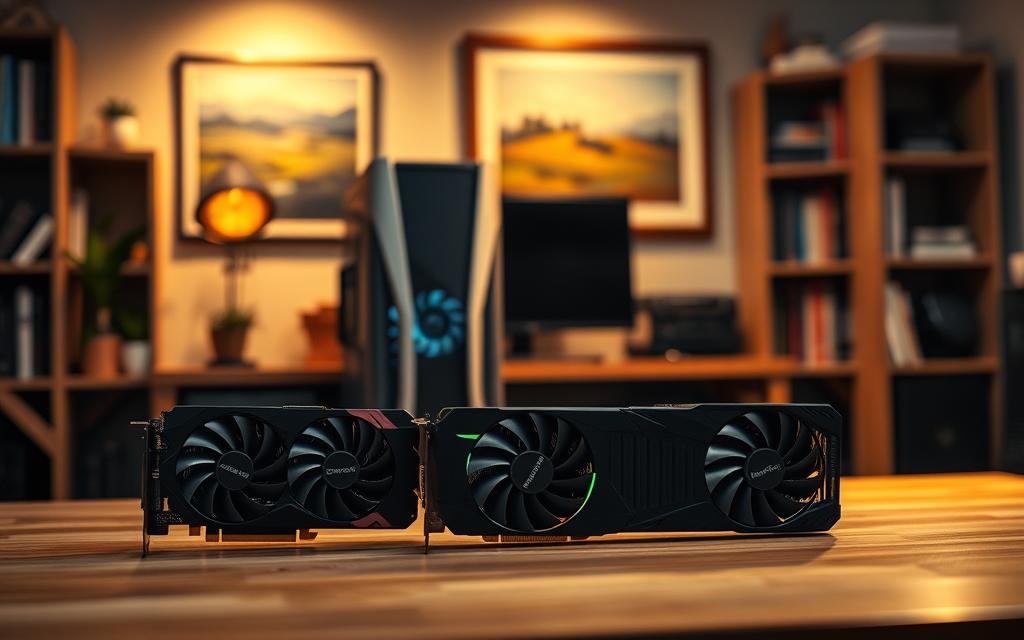
Best GPUs Under $300
For gamers on a tight budget, the Intel Arc A580 stands out with its $170 price tag and 47.2 FPS at 1080p. It’s a great choice for casual gaming and esports titles. Another contender is the RX 7600, priced at $260, which remains a leader in the sub-$300 segment. Both GPUs offer excellent value for their prices.
When considering used market alternatives, factory overclocked models can provide additional performance. However, ensure compatibility with PCIe 3.0 if your motherboard doesn’t support PCIe 4.0. Power efficiency is another key factor, with both the Arc A580 and RX 7600 designed to minimize energy consumption.
- Esports Optimization: Both GPUs handle popular titles like Valorant and CS:GO with ease.
- Warranty Terms: Check for extended warranties to protect your investment.
- Mining Card Risks: Avoid GPUs previously used for cryptocurrency mining to ensure longevity.
Mid-Range GPUs Under $500
For those willing to spend a bit more, the RTX 4060 dominates the sub-$350 segment. Priced at $320, it delivers 66.2 FPS at 1080p, making it ideal for demanding AAA titles. Its DLSS 3 support further enhances performance, ensuring smoother gameplay in supported games.
When upgrading, consider the upgrade cycle of your GPU. Mid-range options like the RTX 4060 provide a solid foundation for future-proofing. Additionally, review power efficiency metrics to ensure your PSU can handle the card’s requirements.
| Feature | Intel Arc A580 | RX 7600 | RTX 4060 |
|---|---|---|---|
| Price | $170 | $260 | $320 |
| FPS at 1080p | 47.2 | 52.9 | 66.2 |
| Power Efficiency | High | Moderate | High |
| Warranty | 3 Years | 2 Years | 3 Years |
“Choosing the right GPU within your budget ensures a smooth gaming experience without overspending.”
Whether you opt for the Arc A580, RX 7600, or RTX 4060, these graphics cards offer excellent performance for their prices. By considering factors like PCIe compatibility, power efficiency, and warranty terms, you can make an informed decision that fits your gaming needs.
High-End Graphics Cards for Enthusiasts
For gaming enthusiasts seeking unparalleled performance, high-end GPUs are the ultimate choice. These powerhouses are designed to handle the most demanding titles, offering cutting-edge features and unmatched visuals. Whether you’re a competitive gamer or a content creator, investing in a top-tier GPU ensures you stay ahead of the curve.
Top GPUs for Extreme Gaming Performance
The RTX 5090 and RX 7900 XTX are leading the charge in 2025. The RTX 5090, priced at $3,999, achieves an impressive 168.3 FPS at 1080p, making it a favorite among hardcore gamers. Its advanced architecture and 24GB GDDR6X memory ensure smooth gameplay even in the most demanding scenarios.
Liquid-cooled models add a $300+ premium but offer superior thermal performance, reducing noise and enhancing longevity. Custom PCB designs and LN2 overclocking potential further push the boundaries of what these GPUs can achieve.
- Market Dynamics: Halo products like the RTX 5090 drive innovation and set benchmarks for the industry.
- Build Quality: High-end GPUs feature premium materials and advanced cooling solutions.
- Collector Value: Limited editions and unique designs appeal to enthusiasts and collectors alike.
Is It Worth Investing in a High-End GPU?
Investing in a high-end GPU is a significant decision that depends on your needs and budget. For gamers who demand the best, the RTX 5090 and RX 7900 XTX deliver exceptional performance and future-proofing. These GPUs excel in content creation workloads, making them versatile for professionals.
Resale value retention is another factor to consider. High-end GPUs often retain their value better than mid-range options, especially if they’re well-maintained. Additionally, the performance gap between generations ensures that these GPUs remain relevant for years.
“High-end GPUs are not just about raw power; they’re about delivering a seamless and immersive experience that justifies the investment.”
When comparing content creation workloads, the RTX 5090 outperforms its competitors in rendering and encoding tasks. Its AI acceleration and ray tracing capabilities make it a top choice for professionals.
Ultimately, the decision to invest in a high-end GPU comes down to your priorities. If you value cutting-edge performance and longevity, these GPUs are worth every penny.
Future-Proofing Your Gaming PC with the Right GPU
Future-proofing your gaming PC starts with choosing the right GPU. As games become more demanding, selecting a GPU that can handle future titles is crucial. A well-chosen GPU ensures your system remains competitive for years to come.
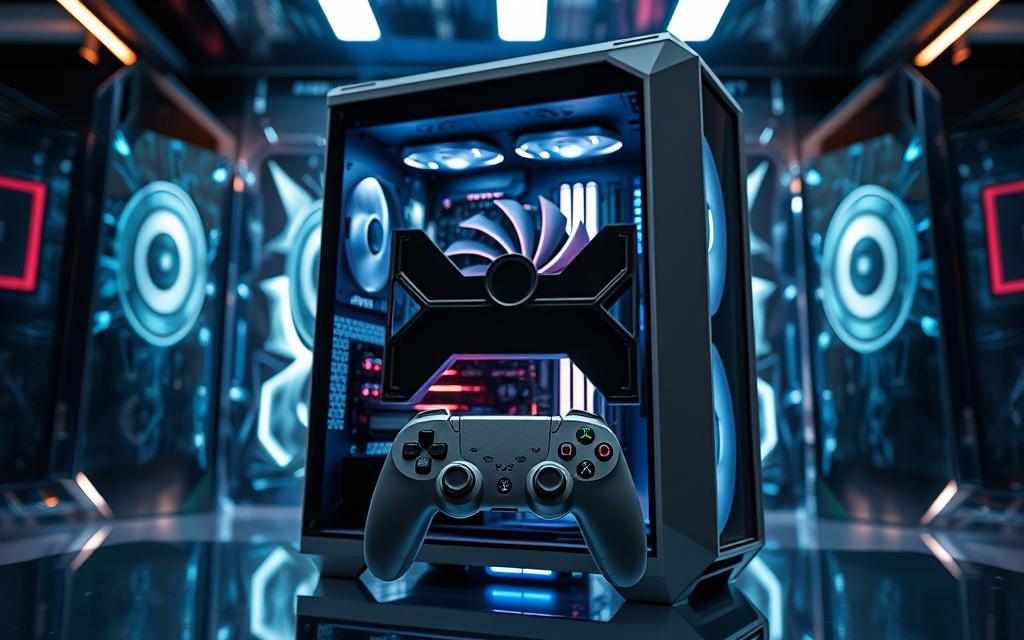
Modern games require advanced features like ray tracing and high settings, making GPU selection a critical decision. By focusing on key factors like VRAM and compatibility, you can build a setup that stands the test of time.
How to Choose a GPU That Will Last
When selecting a GPU for longevity, consider its performance and feature set. PCIe 5.0 x16 interfaces provide the bandwidth needed for future upgrades, while DX12 Ultimate certification ensures compatibility with upcoming games.
Analyzing VRAM requirements is essential. Titles in 2025 and beyond may demand 16GB or more, especially for 4K gaming. GDDR7 memory offers better longevity compared to GDDR6, ensuring your GPU remains relevant.
- Memory Bus Width: Wider buses improve data transfer rates, enhancing performance.
- Firmware Updates: Regular updates ensure compatibility with new games and technologies.
- API Support: DirectX 12 Ultimate and Vulkan support future-proof your GPU.
The Role of VRAM in Future-Proofing
VRAM plays a pivotal role in future-proofing your gaming PC. As games grow in complexity, higher VRAM capacities become necessary. For 4K gaming, 16GB is the recommended minimum to handle high textures and advanced settings.
Multi-GPU scalability is another consideration. While single-GPU setups are more common, multi-GPU configurations can extend the lifespan of your system. However, ensure your power supply and case can accommodate such setups.
“Investing in a GPU with ample VRAM and advanced features ensures your gaming PC remains competitive for years.”
By 2026-2027, games are expected to push hardware even further. Choosing a GPU with future-proof features like PCIe 5.0 and DX12 Ultimate ensures your system is ready for the next generation of gaming.
GPU Pricing Trends in 2025
The GPU market in 2025 is shaped by dynamic pricing trends influenced by supply chain challenges and evolving consumer demands. Factors like AI chip production and import tariffs are driving significant changes in prices, making it essential for buyers to stay informed.
Understanding these trends can help you make smarter purchasing decisions, whether you’re on a tight budget or seeking high-end performance. Let’s explore how supply and demand affect GPU prices and share tips for finding the best deals.
How Supply and Demand Affect GPU Prices
In 2025, GPU prices are heavily impacted by supply shortages and increased demand. The RTX 5080, for example, is selling at 150% of its MSRP due to limited availability. AI chip production has diverted manufacturing capacity, further straining the market.
Import tariffs have added an additional 25% to costs for U.S. buyers, making it harder to find affordable options. These factors create a competitive market where timing and research are crucial.
- Component Costs: Analyze cost breakdowns to understand where your money is going.
- Regional Differences: Compare prices across regions to identify savings opportunities.
- Cryptocurrency Impact: The crypto market continues to influence GPU availability and pricing.
Tips for Finding the Best Deals on GPUs
Finding the best value in 2025 requires strategic planning. Retailer price tracking tools can help you monitor fluctuations and identify the right time to buy. Bundle deals often provide additional savings, especially when paired with compatible hardware.
Consider OEM channels for potential discounts, but be mindful of warranty and support differences. Import taxes can also affect your final cost, so factor these into your budget.
“Staying informed about market trends and leveraging tools can help you secure the best value for your money.”
As we approach Q4 2025, expect prices to stabilize slightly, but early planning remains key to avoiding premium costs.
How to Build a Gaming PC Around Your GPU
Building a gaming PC around your GPU ensures optimal performance and compatibility. The GPU is the heart of your gaming setup, but it needs the right supporting components to shine. From selecting the right CPU to ensuring your power supply can handle the load, every detail matters.
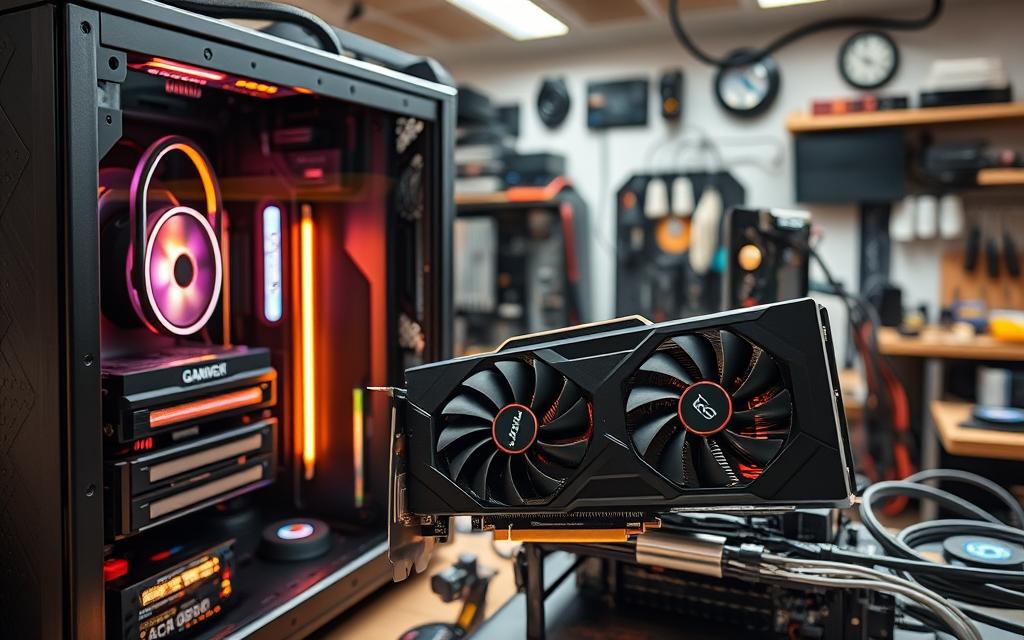
Choosing the Right CPU for Your GPU
Pairing your GPU with the right CPU is crucial for avoiding bottlenecks. The Ryzen 9 7950X3D is an excellent choice for high-end GPUs like the RTX 5090, minimizing CPU bottlenecks and maximizing performance. Analyze CPU-GPU balance ratios to ensure both components work in harmony.
Consider PCIe riser cables if you’re building in a compact case. These cables help position your GPU for better airflow and aesthetics. Review your case airflow requirements to keep temperatures in check, especially with high-power GPUs.
Ensuring Your Power Supply Can Handle Your GPU
High-end GPUs like the RTX 5090 require a robust power supply. A PSU with 850W or more is recommended to handle transient spikes and ensure stability. The ATX 3.0 standard provides better protection against these spikes, making it a future-proof choice.
- Modular PSUs: These allow for better cable management and airflow.
- Dual vs Single Rail: Dual rail designs offer more stability for high-power setups.
- Wattage Calculation: Use online calculators to determine your exact power needs.
- UPS Solutions: A UPS can protect your system from sudden power outages.
“Investing in a quality PSU ensures your gaming PC runs smoothly and safely, even under heavy loads.”
By carefully selecting your CPU and PSU, you can build a gaming PC that delivers top-tier performance for years to come. Whether you’re playing the latest games or pushing high settings, the right setup makes all the difference.
Common Mistakes to Avoid When Buying a GPU
Avoiding common pitfalls when purchasing a GPU can save you time and money. Many buyers overlook critical factors, leading to compatibility issues, overspending, or underperformance. By understanding these mistakes, you can make a smarter investment in your gaming setup.
Overlooking Compatibility Issues
One of the most frequent errors is ignoring compatibility. About 23% of buyers face PCIe slot mismatches, preventing their card from fitting into their motherboard. Always check the physical dimensions of the GPU and ensure it aligns with your case and motherboard.
BIOS compatibility is another concern. Some older motherboards may not support newer GPUs, requiring firmware updates. Additionally, verify display outputs to avoid conflicts with your monitor setup.
- Counterfeit Detection: Purchase from reputable sellers to avoid fake cards.
- Warranty Claims: Compare warranty terms to ensure protection.
- Return Policies: Check return policies in case of incompatibility.
Focusing Too Much on Brand Over Performance
While brand loyalty is common, prioritizing brand over performance can lead to overspending. About 40% of buyers pay for unnecessary features, such as advanced ray tracing capabilities they may never use. Focus on benchmarks and real-world performance instead of brand reputation.
Balancing your budget with your needs is crucial. High-end brands often charge a premium, but mid-range options may offer better value for casual gamers.
“A well-researched purchase ensures you get the best performance without overspending.”
To avoid these mistakes, create a pre-purchase checklist. Include factors like compatibility, performance benchmarks, and warranty terms. Benchmarking validation can also help you confirm the GPU meets your expectations.
Conclusion: Choosing the Right Graphics Card for Your Gaming PC in 2025
Selecting the perfect GPU for your gaming setup in 2025 involves balancing performance, value, and future-proofing. For 1080p gaming, budget-friendly options like the RX 7600 deliver excellent results. Mid-range GPUs such as the RTX 4070 are ideal for 1440p, while high-end models like the RTX 5090 excel in 4K gaming.
Emerging technologies like DLSS 4 and ray tracing are reshaping the gaming experience. These advancements ensure smoother visuals and enhanced realism. However, staying prepared for market fluctuations is crucial. Prices may vary due to supply chain challenges, so timing your purchase wisely can save you money.
Before buying, consider a final checklist: ensure compatibility, evaluate VRAM needs, and assess power requirements. Building a balanced system around your graphics card ensures optimal performance. As 2026 approaches, expect even more innovations in GPU technology, making future-proofing essential.
Ultimately, choosing the right graphics card is about aligning your needs with your budget. Whether you prioritize value or cutting-edge features, a well-researched decision ensures a seamless gaming experience for years to come.
FAQ
What factors should I consider when choosing a GPU for gaming in 2025?
Focus on performance, resolution support, ray tracing capabilities, and VRAM. Match the GPU to your monitor’s resolution and ensure it fits your budget and power supply requirements.
How important is ray tracing for modern gaming?
Ray tracing significantly enhances visual realism by simulating light behavior. While not essential for all games, it’s a key feature in titles like Cyberpunk 2077 and Call of Duty. GPUs like the Nvidia GeForce RTX 4060 or AMD Radeon 7900 XTX excel in this area.
Is it worth investing in a high-end GPU like the RTX 4090?
If you’re gaming at 4K resolution or want future-proofing, the RTX 4090 offers unmatched performance. However, mid-range options like the RTX 4070 or AMD Radeon 7900 XTX provide excellent value for most gamers.
How does VRAM affect gaming performance?
VRAM determines how well a GPU handles high-resolution textures and complex scenes. For 1080p gaming, 8GB is sufficient, but 4K gaming often requires 12GB or more, especially for future-proofing.
Should I choose AMD or Nvidia for gaming in 2025?
Both brands offer strong options. Nvidia leads in ray tracing and DLSS, while AMD often provides better value in terms of price-to-performance. Consider your specific needs and budget.
Are Intel Arc GPUs a good choice for gaming?
Intel Arc GPUs, like the Arc A750, are competitive in the budget and mid-range segments. They’re a viable option for 1080p and 1440p gaming, though they may lack the driver support of Nvidia and AMD.
What’s the best GPU for 1080p gaming in 2025?
For 1080p gaming, the Nvidia GeForce RTX 4060 or AMD Radeon 7600 are excellent choices. They offer strong performance at a reasonable price, making them ideal for most gamers.
How do I ensure my GPU is future-proof?
Opt for a GPU with ample VRAM, support for ray tracing, and compatibility with DLSS or FSR. Models like the RTX 4070 or AMD Radeon 7900 XTX are designed to handle future gaming demands.
What’s the difference between DLSS and FSR?
DLSS (Nvidia) and FSR (AMD) are upscaling technologies that boost performance without sacrificing visual quality. DLSS is generally more advanced, but FSR works across a wider range of GPUs.
How do I find the best deals on GPUs in 2025?
Monitor market trends, check for sales during holiday seasons, and compare prices across retailers. Consider refurbished or previous-generation models for additional savings.


